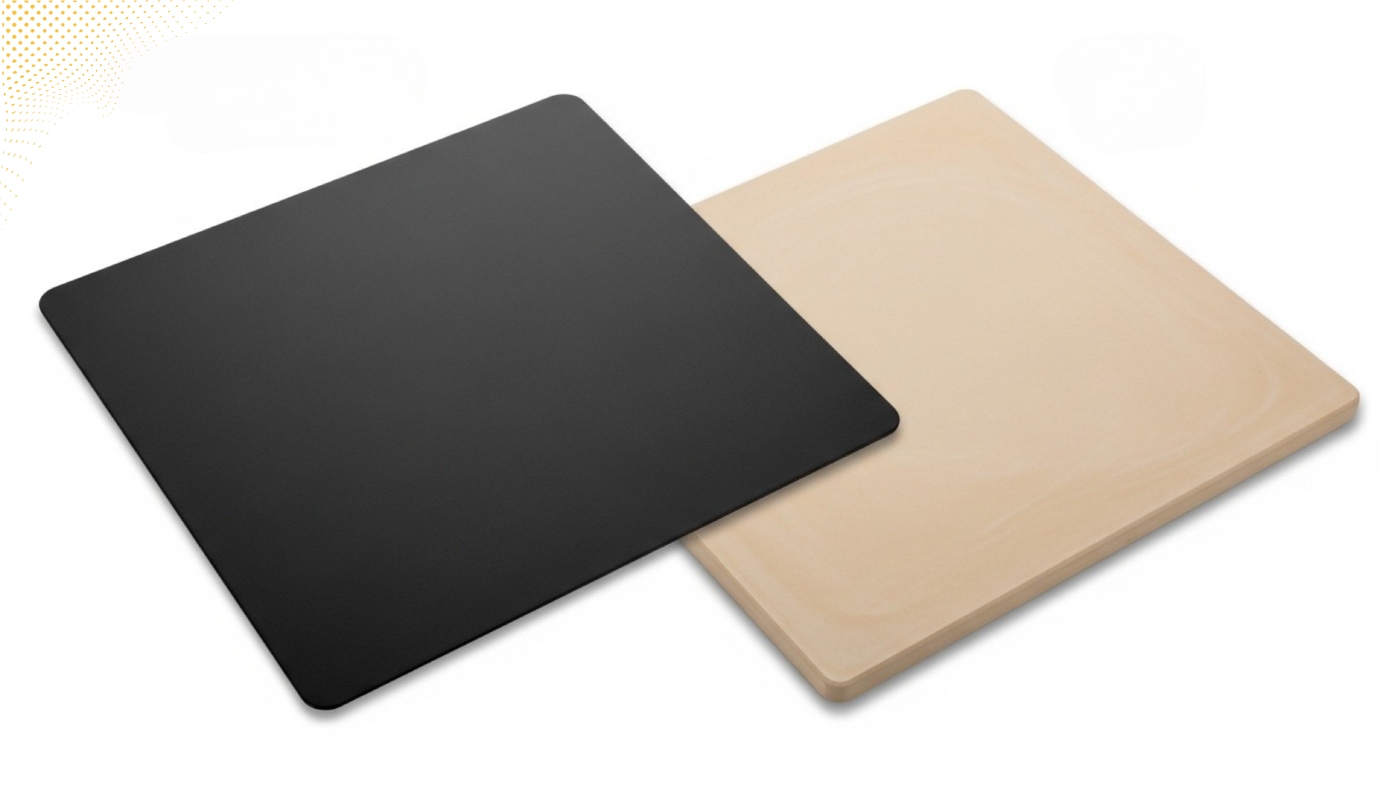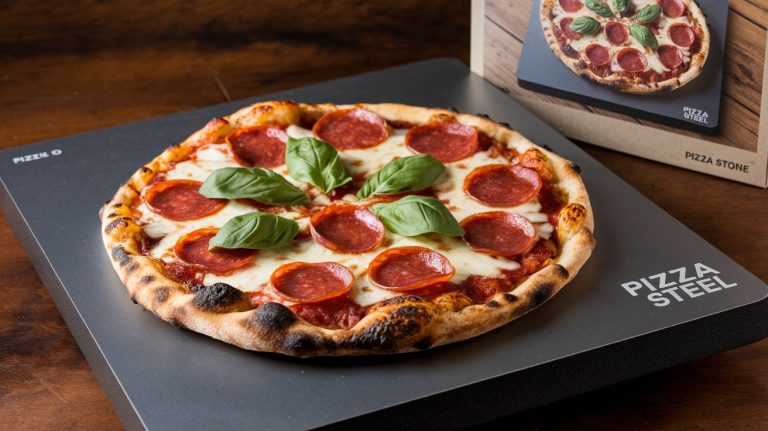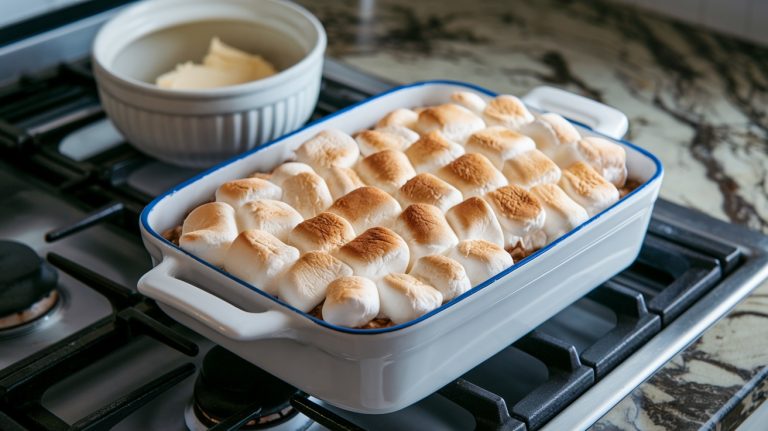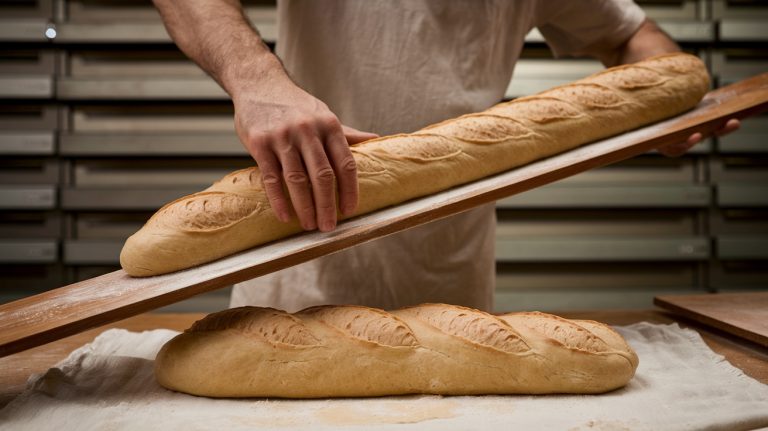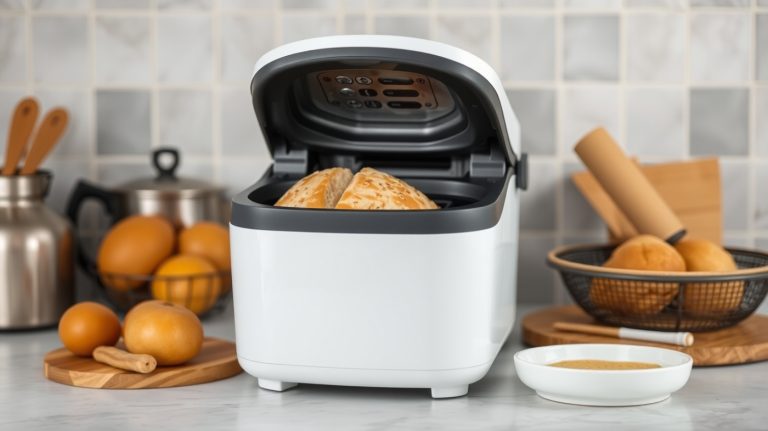Baking Steel vs Stone: Bake Smarter, Not Harder
If you want faster, more even baking with superior durability, baking steel outperforms pizza stone. Steel’s carbon material transfers heat 20 times more efficiently, giving you crispier crusts and shorter bake times.
It’s nearly indestructible and resists cracks and thermal shock, unlike fragile stones. However, steel is heavier and requires seasoning to prevent rust, while stones are lighter and porous. Choosing steel elevates your baking – let’s explore how each option suits your needs.
- BETTER AND TASTIER — The secret of a better and tastier pizza is to replicate the original cooking…
- EFFECTIVE AND FASTER HEAT CONDUCTION —Reach very high temperatures while maintaining an equal…
- FASTER COOKING and SERVING— Using our pizza oven steel plates is just like relying on a direct…
- PIZZA STONE FOR GRILL AND OVEN: Our very best pizza stone formulated from toughened porous…
- BAKING STONE: Multiple use set for baking Italian style pizza, pies, pastry, frozen pizza, calzone…
- INDOOR OR OUTDOOR: The perfect stone pizza pan for oven and BBQ use. Dine al fresco under the stars…
Key Takeaways
- Baking steels conduct heat about 20 times faster than stones, delivering quicker, crispier crusts and shorter baking times.
- Steel is nearly indestructible and resists cracking, while stones are fragile and prone to thermal shock damage.
- Stones are porous and absorb moisture, making them harder to clean, whereas steel surfaces are smooth and easier to maintain.
- Steel weighs roughly four times more than stone, impacting portability and handling during use and storage.
- Although more expensive upfront, baking steels offer superior durability, heat performance, and long-term value compared to stones.
Detailed Comparison Table on Baking Steel Versus Stone
| Aspect | Baking Steel | Baking Stone |
|---|---|---|
| Material Composition | Carbon steel (approximately 6mm thick) with polished surface | Ceramic minerals (cordierite, mullite, or terracotta) with porous texture |
| Heat Conductivity | 20 times faster heat transfer than stone, exceptional conductivity | Moderate heat transfer, retains heat longer but transfers slower |
| Preheating Time | 30 minutes to reach optimal temperature | Longer preheating required due to slower heat absorption |
| Cooking Performance | 4-6 minute cooking times, instant sizzle effect, superior crust formation | Longer cooking times, gentler heat transfer, chewier crust texture |
| Temperature Capability | Can reach 700°F+ temperatures, replicates professional oven conditions | Lower maximum temperatures, better for moderate heat baking |
| Durability | Nearly indestructible, crack-proof, resists thermal shock | Prone to cracking, fragile, sensitive to thermal shock |
| Weight | 4 times heavier than stone, often exceeding 16 pounds | Lighter weight, typically 8-13 pounds, easier handling |
| Maintenance Requirements | Requires regular seasoning to prevent rust, needs oiling and drying | Minimal maintenance, avoid rapid cooling, no rust concerns |
| Surface Properties | Smooth, non-porous surface, easy to clean | Porous texture, absorbs moisture and oils, harder to clean |
| Longevity | Decades of use, withstands abrasion and impacts | Wears with cracks and chips, limited lifespan |
| Price Range | $80-$170 depending on thickness and size | $32-$80, more affordable initial investment |
| Portability | Difficult to maneuver, requires careful handling, storage challenges | Easier handling, simpler transport and storage |
| Versatility | Multi-purpose use beyond pizza (griddle for pancakes, omelets) | Primarily for baking applications, limited versatility |
| Heat Recovery | Quick heat recovery between batches, energy efficient | Slower heat recovery, less efficient for multiple batches |
| Crust Results | Crispy, well-browned crust with rapid oven spring | Chewier, drier crust with traditional rustic flavors |
| Environmental Resistance | Moisture-resistant, stable in various conditions | Absorbs moisture, thermal shock sensitive |
| Long-term Value | Superior long-term value despite higher upfront cost | May require replacement due to cracking, lower long-term value |
Material and Build Differences
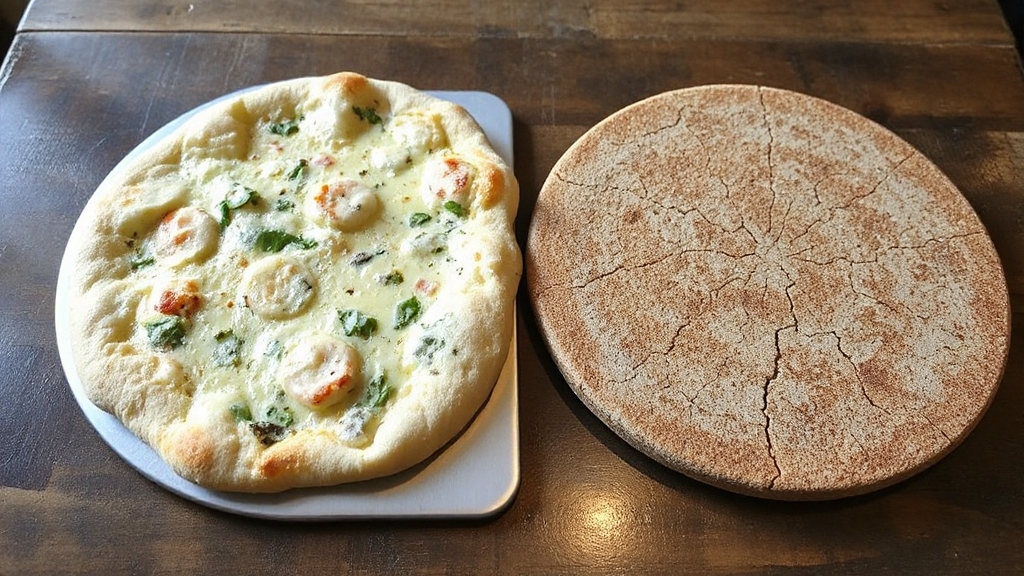
Although baking steels and stones both serve as heat-retentive baking surfaces, they differ fundamentally in material composition and durability. Baking steels consist of thick, approximately 6 mm carbon steel, offering superior strength, resistance to thermal shock, and longevity.
Their polished surfaces facilitate consistent dough contact and ease of cleaning, though they require seasoning to prevent rust. Baking steels are known for their superior heat absorption and transfer capabilities compared to stones. Their ability to maintain and evenly distribute heat makes them ideal for achieving well-baked sourdough crusts with precise temperature control, which is critical for consistent baking results.
In contrast, baking stones are primarily composed of ceramic minerals like cordierite or mullite; cordierite provides moderate thermal shock resistance, while terracotta variants are more fragile and prone to cracking. Stones feature a porous, rough texture that absorbs moisture and oils, complicating maintenance.
The porous nature of stones can affect heat retention, making them less efficient in sustaining the consistent temperatures preferred in artisan baking. Steel’s robust construction withstands impacts and extreme heat fluctuations, whereas stones demand careful handling and gradual temperature changes to avoid damage, limiting their lifespan relative to steel counterparts.
Heat Transfer and Cooking Efficiency
When you place dough on a baking steel, its exceptional heat conductivity—about 20 times greater than that of stone—delivers an immediate, intense heat transfer that rapidly forms a crispy, well-browned crust. This rapid heat conduction causes an instant sizzle, promoting a swift oven spring and efficient crust formation.
Steel stores significantly more heat than stone, which enhances oven spring and crust crispiness. The superior heat transfer capability of baking steel makes it especially effective for baking crusty breads like sourdough, which benefit from quick and even crust development.
The steel preheats faster, typically within 30 minutes, and sustains high heat for 4-6 minute cooking times, markedly reducing bake duration compared to stone. Its thermal mass allows quick heat recovery between batches, ensuring consistent results and energy efficiency during frequent use. This advantage parallels the use of ergonomic tools such as the PAUDIN 10 Inch Serrated Bread Knife, which is designed for efficiency and precision in handling crusty bread.
While stones retain heat longer, steels excel at high-heat baking by transferring heat directly and efficiently to the dough, replicating professional oven conditions with superior cooking performance.
Durability and Maintenance Considerations
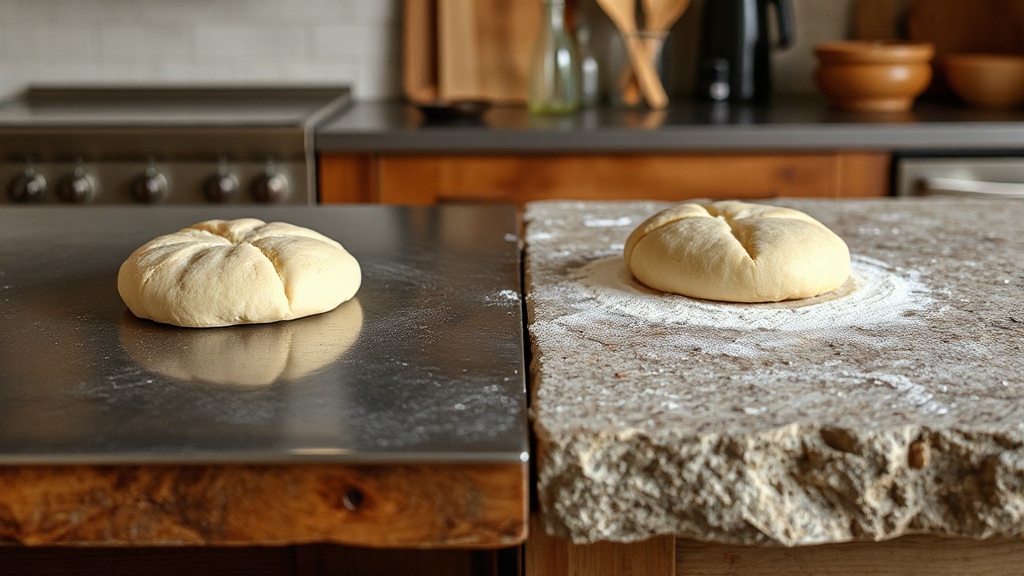
Since durability directly impacts long-term value and maintenance effort, understanding the contrasting properties of baking steels and stones is essential. Baking steels resist cracking, last decades, and require regular seasoning to prevent rust. They also heat quickly due to superior thermal conductivity, making them nearly indestructible under normal use.
Their ability to maintain even heat is comparable to heavy-duty bakeware favored for consistent results. Stones, prone to thermal shock and cracking, need cautious cooling and gentle cleaning. You’ll find steels demand oiling and drying after use, while stones avoid rust but may absorb moisture and develop surface wear.
| Aspect | Baking Steel | Baking Stone |
|---|---|---|
| Durability | Extremely durable, crack-proof | Prone to cracking, fragile |
| Maintenance | Requires seasoning, drying | Minimal; avoid rapid cooling |
| Environmental Res. | Moisture-resistant, stable | Absorbs moisture, thermal shock sensitive |
| Longevity | Decades, withstands abrasion | Wears with cracks and chips |
Weight, Portability and Handling
Because steel is about four times denser than stone, baking steels weigh considerably more than baking stones, often exceeding 16 pounds even at thinner profiles. A 16×16 inch steel can weigh around 22 pounds, while stones typically range from 8 to 13 pounds.
This significant weight impacts portability; you’ll find steels harder to maneuver in and out of ovens and more demanding to store securely. Handling requires caution to avoid safety risks, as steels lack built-in grips and can cause strain.
Prioritizing a steel with around 16 pounds and a 1/4-inch thickness can help balance weight and performance for home oven use, but it still remains heavier than stone due to its material density. The shelf life of baking materials can affect their performance and maintenance needs over time.
Stones, made from lighter ceramic or stone, offer easier handling, simpler cleaning, and no rust concerns. While steel demands careful lifting and seasoning maintenance, stones provide a practical advantage in ease of use and transport without sacrificing storage convenience.
Cost Comparison and Value for Money
How does the cost of baking steel compare to that of baking stone, and what value do you get for your investment? Baking stones range from $32 to $80, while baking steels start around $80 and can reach $170 for thicker models.
Although steels carry a higher upfront cost, they outperform stones in heat conductivity and durability, justifying the expense. Steels resist cracking and last a lifetime, providing superior long-term value. Additionally, their heat retention capabilities make them excellent for consistent baking performance.
You’ll find cost per use decreases with frequent baking, making steels more cost-effective over time. Stones, though more affordable initially, may require replacement due to thermal shock.
Additionally, steels offer versatility beyond pizza, enhancing their utility. A baking steel can reach temperatures of 700°F+, enabling pizzas to cook in as little as four minutes, which stones typically cannot match.
If you bake often and seek consistent, high-quality results, investing in a baking steel delivers better performance and value than a baking stone.
Frequently Asked Questions
Can Baking Steel or Stone Be Used on a Grill or Campfire?
Yes, you can use both baking steels and stones on grills or campfires, but baking steel is more durable and heats faster.
On gas grills, preheat steel to around 400°F for 30 minutes, then reduce heat for even cooking.
On charcoal or campfires, place steel directly on grates or coals for rapid heat conduction.
Stones need slower, indirect heating to avoid cracking, while steel withstands direct flames and thermal shock efficiently.
How Do Baking Steel and Stone Affect the Taste of Bread or Pizza?
Imagine your crust crisping like autumn leaves underfoot—that’s what happens with steel’s rapid heat transfer, giving you a crispy, airy crust with a slight char, enhancing flavor complexity.
Stone, however, imparts a gentler heat, producing a chewier, drier crust with subtle smoky notes.
You’ll find steel sharpens crust texture and browning, while stone fosters traditional, rustic flavors and moisture balance, shaping distinct taste profiles through their unique thermal dynamics.
Are There Any Safety Concerns With Using Baking Steel or Stone?
You won’t face chemical hazards using baking steel since it’s made from solid, low-carbon steel without coatings or harmful metals. It resists thermal shock and is easy to sanitize.
Baking stones are inert but can crack with sudden temperature changes, posing physical risks. Both require careful handling due to weight and proper cleaning to avoid bacterial growth.
Avoid rapid temperature shifts and store them dry to guarantee safe, long-term use.
What Cleaning Products Are Safe to Use on Baking Steels and Stones?
Did you know that improper cleaning can reduce your cookware’s lifespan by up to 40%?
For baking steels, you can safely use soap and water when prepping to re-season, plus eco-friendly Baking Steel Cleaning Bricks made from recycled glass. Avoid harsh chemicals to protect seasoning.
For pizza stones, skip soap; use water and a soft brush instead, or a baking soda paste for tough stains. Ensure you dry them thoroughly afterward.
Can Baking Steel or Stone Be Customized or Cut to Fit Specific Ovens?
You can customize baking steel by having it precisely cut to your oven’s dimensions, thanks to its durability and resistance to shattering. Fabrication services offer thickness options and surface treatments to enhance performance.
Conversely, pizza stones can’t be safely cut or resized due to their brittle nature, requiring you to choose exact dimensions upfront.
Custom steel maximizes heat retention and fits odd oven shapes, while stones demand precise measurements to avoid damage.
Steel or Stone, Select Your Baking Foundation
When choosing between baking steel and stone, consider that baking steel transfers heat up to 15 times faster than stone, ensuring quicker, crisper results. Its superior thermal conductivity means you’ll achieve professional-quality crusts with less preheating time.
While steel demands careful maintenance to prevent rust, its durability and efficiency often justify the investment. Ultimately, your choice hinges on balancing heat performance, upkeep, and portability to match your specific baking needs.
- Rectangular Baking Stone: The baking stone measures 15″L x 12″W with 0.6” thickness and weighs…
- Even Cooking: The oven stone is made of high-quality Cordierite, heat-resistant up to 1,450°F…
- Absorbs Moisture: The porous surface of the pizza cooking stone effectively absorbs excess moisture…
- ULTIMATE PIZZA STEEL AND PEEL SET: Our pizza baking steel and beechwood handle peel have gone…
- ITALIAN PIZZA IN OVEN OR BBQ: This baking steel pizza steel transforms your homemade pizza into a…
- EASY MAINTENANCE: This steel pizza stone for oven is super easy to clean and maintain. Its smooth…
Last update on 2025-10-29 / Affiliate links / Images from Amazon Product Advertising API

